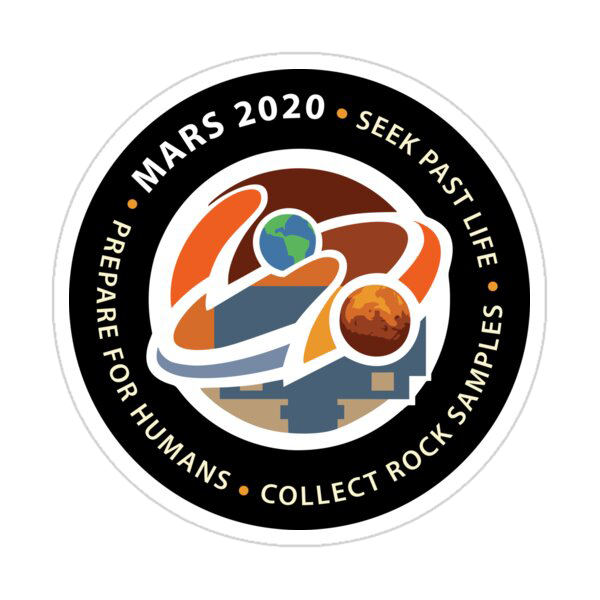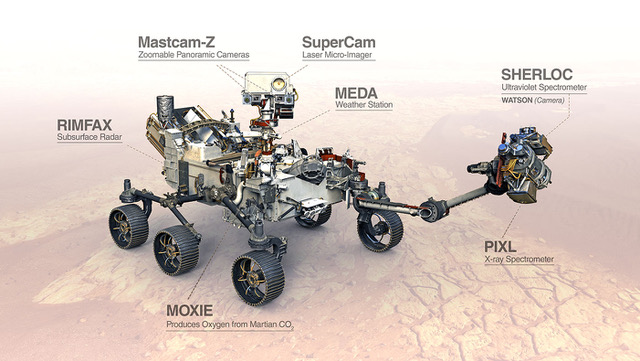- Verify and validate the technology of Mars ISRU as a springboard for the future
- Establish achievable performance requirements and design approaches that will lead to a full-scale ISRU system based on MOXIE technology.
- To be capable of producing at least 6 g/hr of oxygen in the context of the Mars 2020 mission (assuming atmospheric intake at 5 Torr, typical of Jezero Crater, and 0°C, typical of the rover interior).
- To produce oxygen with > 98% purity.
- To meet these first two requirements for at least 10 operational cycles after delivery. Since MOXIE is expected to operate in all seasons and at all times of day and night on Mars, these requirements are intended to be satisfied under worst-case environmental conditions, including during a dust storm, if possible.

Feb 22, 2021 (Ls 8.0 MY 36) to [ongoing]

A schematic showing the location of MOXIE and other major instruments. Credit NASA/JPL-Caltec
Experiment Overview
MOXIE is a technology demonstration of In-Situ Resource Utilization (ISRU) technologies to enable propellant and consumable oxygen production from the Martian atmosphere. This demonstration is a precursor to developing the technology to produce the large mass of cryogenic propellants needed to power an ascent vehicle to transport astronauts from the Mars surface to the orbiting return vehicle.
Goals
Requirements
The future ISRU technology would need to be scaled up about 200 times to autonomously provide at least 24 metric tons (MT) of liquid oxygen (LOX) for ascent vehicle propellant in the 16 months preceding the launch of a human crew to Mars.
MOXIE is installed in the belly of a Perseverance, relatively insensitive to external temperatures except for the temperature of the gas intake. An operations cycle will span one martian SOL. And will use a full SOL payload allocation of ∼ 1000 W-hrs. Operation cycles will allow assessment of the robustness of MOXIE’s technical performance (flow rate, oxygen production rate, oxygen purity, voltage–current relationship of SOXE), and provide the opportunity for the team to learn how to optimize performance, and to understand how performance changes with environmental conditions and repeated use. Initial plans are to operate MOXIE 10 times over the course of one Martian Year to access how well it works in varying seasons.

This functional block diagram illustrates the MOXIE process. MOXIE collects CO2 from the Martian atmosphere, then electrochemically splits the CO2 molecules into O2 and CO. The O2 is then analyzed for purity before being vented back out to the Mars atmosphere along with the CO and other exhaust products.
The SOXE operates at 800° C, requiring a sophisticated thermal isolation system, including input gas preheating and exhaust gas cooling. There are O2 exhaust and CO2/CO exhaust streams, which are then analyzed to verify O2 production rate and purity and for process control. The electrical current through the SOXE is a direct result of the oxide ions transported across the electrolyte. The current provides an independent measurement of O2 production rate.
Based on conversion efficiency calculated from flow rates and composition measurements, SOXE control parameters such as CO2 input flow rate, temperature, and applied voltage are used to optimize O2 production under Mars environmental conditions. The cooled exhausts are then filtered to satisfy planetary protection requirements and vented from the Rover. Process telemetry is reported to the Rover for downlink.
Background Publications
Farley, K.A., Williford, K.H., Stack, K.M. et al. Mars 2020 Mission Overview. Space Sci Rev 216, 142 (2020). https://doi.org/10.1007/s11214-020-00762-y
Balaram, J., Aung, M. & Golombek, M.P. The Ingenuity Helicopter on the Perseverance Rover. Space Sci Rev 217, 56 (2021). https://doi.org/10.1007/s11214-021-00815-w
MOXIE Documents
Summary Article - Hecht, M., Hoffman, J., Rapp, D. et al. Mars Oxygen ISRU Experiment (MOXIE). Space Sci Rev 217, 9 (2021). https://doi.org/10.1007/s11214-020-00782-8
Documentation
Introduction
Software Interface Specification document (SIS)
Archive Products
Data from other instruments and rover
During a MOXIE run, data from three other instruments are recorded: the Environmental Dynamics Analyzer (MEDA), SuperCam, and Entry, Descent and Landing camera (EDLcam). In addition, several rover parameters are relevant to MOXIE operation, for example, Rover Avionics Mounting Panel (RAMP) temperature. MEDA records atmospheric pressure, surface temperature, relative humidity, upward and downward radiative fluxes in several solar and infrared bands, and atmospheric temperature, wind speed, and 3D wind direction at ~1.5 m, at 1 Hz. During MOXIE runs, MEDA will record a subset of the above (atmospheric pressure, temperature, optical depth, wind speed, and 3D wind direction at ~1.5 m, at 1 Hz) from 3 minutes before the start of oxygen production until 3 minutes after the end of oxygen production. In addition, MEDA’s Radiation and Dust Sensor-Skycam (RDS)-Skycam is also scheduled to acquire two images of the sky each sol to retrieve optical depth, a measure of atmospheric column dust content.The SuperCam and EDLcam microphones are intended to record audio from one minute before to five minutes after the start of scroll compressor operation; from one minute before to two minutes after any change in scroll compressor RPM commanded via the RCT; and from one minute before to one minute after the end of scroll compressor operation.
Data product description
Bundle
Each MOXIE run is stored in a separate directory identified by martian day (sol), beginning on sol 60 (April 20,2021). A run lasts around 3.5 hours: 2.5 hours of warmup followed by 1 hour of oxygen production. See SIS Quick Start Guide for accessing data.
Each data file (raw, calibrated and derived) is stored as a CSV file and contains time series of parameters sampled at 1 Hz.
Raw Data
contains the original data from the instrument in Digital Numbers (DNs).
Calibrated Data
contains the data converted to physical calibrated Units (CUs).
Derived Data
contains data derived from one or more calibrated or derived quantities, for example oxygen mass production rate in g/hr.
1) Downloading an index, selecting components
Indices that tabulate information associated with each product are available.
Calibrated Index (csv)
Derived Index (csv)
Raw Index (csv)
c. Upload the URN values from your revised index (note the total uncompressed file size before requesting)
Indices that tabulate information associated with each product are available.
Calibrated Index (csv)
Derived Index (csv)
Raw Index (csv)
a. Select your index
b. Sort and make your selection
b. Sort and make your selection
c. Upload the URN values from your revised index (note the total uncompressed file size before requesting)
2) Downloading individual files from the directories by clicking on the files.
Downloading annual collections of data
| MOXIE BUNDLE |
Citing datasets for publication
M. Hecht (2021), Mars Oxygen In-Situ Resource Utilization Experiment (MOXIE), NASA Planetary Data System, DOI XXXXXX.
Spice
Archived SPICE ancillary data providing observation geometry (positions, orientations, instrument pointing, time conversions, etc.) are available from the PDS NAIF Node.
 PDS: The Planetary Atmospheres Node
PDS: The Planetary Atmospheres Node

